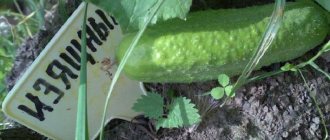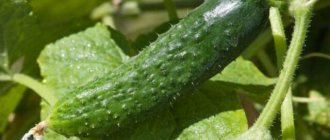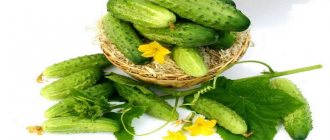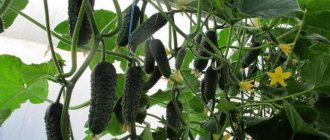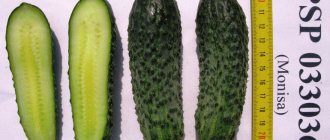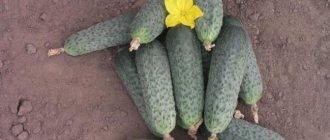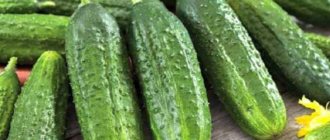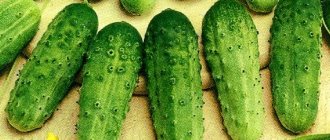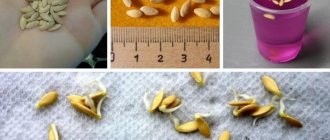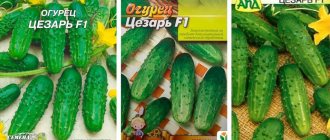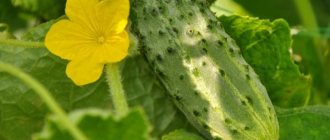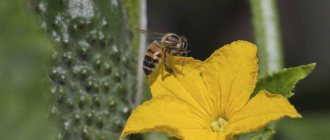History of selection of a popular hybrid
Murashka F1 is a first generation hybrid. Work on it was carried out in the scientific division of agro - Research Institute of Vegetable Growing of Protected Soil. In 2003, the Murashka cucumber was included in the State Register. The research institute continued work to improve its characteristics.
Murashka, along with cucumber hybrids Kurazh, Piknik, Pyzhik from, has been a sales leader for about 10 years. Breeders have achieved improvements in economically important traits. Murashka's yield, manufacturability, taste, and immunity meet modern requirements.
Productivity
Hybrid Murashka F1 is considered high-yielding, and its performance is little dependent on weather conditions. Commercial yield reaches 12 kg/m2. Such indicators are most often typical for greenhouse farms, when cultivation is carried out by professionals. For gardeners and summer residents, this parameter fluctuates around 10.5-11 kg/m2 when cultivated in open beds.
Related article:
Bettina cucumber F1 - description of a Dutch, early-ripening variety
The yield is indicated per unit area, since even denser planting of bushes will not become more effective, there will still be the same amount of fruits as indicated earlier, they will just be smaller. This is due to the fact that the root system needs a certain amount of area to properly supply plants with nutrients.
With dense plantings of Murashka F1, nutritional deficiency occurs, and the risk of infectious diseases increases.
After reaching technical ripeness, the fruits retain their good appearance even if the harvest is not harvested on time.
Advantages and disadvantages
Assessing the advantages and disadvantages of a modern hybrid will help you make the right choice. Description of the disadvantages of Murashka cucumber:
- low resistance to the causative agent of peronosporosis;
- high risk of rot (root).
A feature of the hybrid that cannot be considered a direct disadvantage is that the yield is higher when growing cucumbers in seedlings.
List of advantages of Murashka cucumber:
- no barren flower;
- precocity;
- no bitterness;
- resistance to powdery mildew;
- ease of care;
- commercial greens.
Formation of a bush - basic rules
As they grow, indeterminate cucumbers need pinching and pinching.
Many recommendations have been written on how to shape cucumbers. Most of them boil down to these step-by-step instructions:
Step 1. The planted bushes, when they take root and begin to grow, are tied to a support.
Step 2. At the bottom of the bush, “blinding” is carried out - four true leaves are removed. This is done in order to improve access of light and air to the plant. This prevents the development of putrefactive processes provoked by increased foliage of the plant.
Step 3. When the vine reaches 0.5-1 m in height (level 5-6 leaves), it is necessary to pinch the side stems, leaving one ovary and the accompanying leaf.
Step 4. After the seventh leaf appears (distance from the soil surface - 1-1.5 m), the side shoots should be pinched after two or three ovaries with leaves.
Step 5. The top can also be pinned. After this, all the plant’s forces will go into the side shoots, where predominantly female flowers are formed, which cannot but affect the amount of harvest. Throwing the whip over the wire, leave about 70 cm of the stem and pinch off its upper part.
Characteristics of the variety
The type of central stem of cucumber is indeterminate. The number of side shoots is average; they are of a determinate type with short internodes. The leaf size is medium, the surface is smooth, the color is light green. Bunches of ovaries (2-4 pieces) are formed in the sinuses. Ripening period is 35 days.
Fruits and yield
From 1 m² you get 11 kg of fruit. The yield of Murashka cucumber is negatively affected by sharp changes in night and day temperatures. Characteristics of the Murashka cucumber fruit:
- coarsely tuberous;
- black-thorned;
- cylindrical;
- weight 100 g;
- size 4 x 11 cm;
- the color is dark green at the base, light green at the tip;
- the taste is sweetish.
Reviews about the quality of the fruits of the Murashka hybrid are good. They are used for all types of workpieces. Pickled Murashka cucumbers are especially good. They are always crispy.
Susceptibility to diseases and insects
Signs of peronosporosis may appear on the bushes. At the first stage, these are yellowish spots of an oily nature on the outside of the leaves. In the late stage, the leaves dry out, lighten, and curl into a tube.
Murashka cucumber bushes are susceptible to root rot. It is not difficult to recognize a diseased plant. Signs appear in the root zone:
- stem brown;
- the leaves turn yellow, the shoots become thinner.
Description of cucumber Murashka F1
The cucumber with the original name was bred by agro breeders. Included in the State Register in 2003. The breeders did an excellent job of creating a productive early-ripening variety; it is no coincidence that Murashka F1 constantly occupies leading positions in various cucumber ratings.
The parthenocarpic hybrid is recommended for cultivation in a number of regions:
- Middle Volga;
- Northwestern;
- Volgo-Vyatsky;
- Northern.
There are seven regions in total on the recommended list, although summer residents and farmers grow Murashka throughout the country. He was also loved in the CIS countries: in Ukraine, Moldova, and Belarus. Intended for planting under film shelters, although it also successfully bears fruit on open ground ridges (especially in the southern regions).
Rules for planting in the ground
The success of the future harvest is influenced by the quality of the seeds and the timing of planting cucumber seedlings. For the middle zone, Murashka can be sown at the end of March, the 1st-2nd decade of April. At the beginning of February, the seeds should be poured into a gauze bag and hung next to the radiator. Warming up (20-25 °C) disinfects planting material.
Preparation of soil and planting material
Murashka seeds 2-3 years old are suitable for planting. They have better germination. Before planting, 2 procedures are carried out:
- disinfection;
- hardening.
See also
Why do cucumber leaves turn yellow in a greenhouse and what to do?
Read
For disinfection, prepare a solution: 1 liter of hot water, copper sulfate and boric acid on the tip of a knife, nitrophoska - 1 tsp. The seeds are placed in gauze, moistened in liquid, and left for 12 hours. Wash, harden for 2 days in the refrigerator (0-2 °C). Seeds that have undergone industrial processing are not subjected to these procedures.
To grow cucumber seedlings, prepare cups and pots with a diameter of 12-15 cm. The soil mixture is made up of 1 part peat, 1 part garden soil. For every 10 liter bucket add 2 tbsp. ash, ¼ tbsp. superphosphate.
Sowing seeds
The time spent growing Murashka seedlings is well spent. Gardeners manage to speed up the ripening of greens by 2 weeks. The cups are filled with soil mixture not to the very top and watered. Place 2 seeds in each. Sprinkle with a layer of 2 cm. Place the glasses on a tray and cover with film.
Growing seedlings
Until the shoots appear, the air temperature in the room is maintained at 26-28 °C. After the sprouts appear, the tray is placed on the south window. On cloudy days, additional illumination of seedlings is organized. The room temperature is reduced to 20 °C.
Seedling care includes:
- watering with warm water;
- soil filling;
- fertilizing in the phase of 2 true leaves.
Liquid fertilizer is prepared from 1 liter of water, 1 tsp. nitroammofoski. Murashka seedlings can be fed with Zdraven Turbo. This complex fertilizer accelerates the formation of a strong cucumber root system.
Transplanting into open ground: timing and step-by-step instructions
A week before transplanting, the bed is prepared. Dig to a depth of 25 cm. Water with hot solution:
- water - 10 l;
- liquid mullein - 0.5 l;
- dry bird droppings - 1 tbsp.;
- copper sulfate - 1 tsp.
The bed is covered with a piece of cellophane. The period is determined by the weather and soil warming. On the day of planting, its temperature at a depth of 15-25 cm should not be lower than 15-20 °C. In most regions of the Russian Federation, Murashka seedlings are planted in the ground at the end of May or early June.
The standard planting scheme for hybrids is used - 3 seedlings per 1 m². The algorithm of actions is as follows:
- dig holes the size of a glass;
- 2 tsp are poured onto the bottom. complex fertilizer for cucumbers mixed with soil;
- spill the holes with water;
- transfer the seedlings into the hole;
- sprinkle with soil;
- watered;
- mulch with humus.
The seedling is planted at the same depth at which it grew in the planting container.
Amazing gherkins
Who doesn't love these wonderful pickles, pickled or salted? In winter, they go great with potatoes. Try planting the Mullet F1 cucumber on your plot - this is an early ripening hybrid that has the highest yield. Only 45 days pass from germination to active fruiting, during which time the plant fully grows. The main shoot is quite long, so it is necessary to provide support.
Red mullet is a parthenocarpic hybrid of the female flowering type. It bears fruit well in open ground conditions, as well as in a greenhouse or greenhouse. It will also give excellent results when grown on a balcony; the only inconvenience will be a large bush. Planting of seedlings occurs at the end of April; in May, plants should be planted in open ground. Between the bushes you need to leave a distance of approximately 50 x 50 cm. After a month and a half, the fruits begin to ripen - elegant greens 10-12 cm long and weighing about 100 g. Most often it is used for pickling, but the cucumber is also amazingly tasty in fresh and salted form. It is noteworthy that the fruits ripen in large “bouquets”; there can be 10-15 of them in the nodes on the main shoot. This ensures a friendly yield of the harvest, so you will not only enjoy summer salads to your heart’s content, but also stock up on cucumbers for future use.
Caring for a plant in open ground
Growing a lot of crunchy cucumbers is not easy. Cucumbers are capricious plants. They require simple but proper care.
Watering
It is better to water Murashka cucumbers in the morning. Late evening irrigation causes fungal diseases. Powdery mildew damages plants at night by low temperatures and high humidity.
The health of plants and the quality of fruits is affected by the temperature of the water used for irrigation. Settled and warm (20-25 °C) is considered good. Cold water causes bitterness and ugly fruit shape. The frequency of watering depends on the weather and precipitation, if it is wet - once a week, if it is hot, dry - every other day.
Water consumption depends on the phase:
- before flowering - 4 l/m²;
- during flowering - 10 l/m², but less often;
- during fruiting - 10 l/m² according to the usual scheme.
See also
Why do yellow spots appear on cucumber leaves and what to do?
Read
Stepsoning
Murashka cucumber bushes growing in the ground form. Timely removal of stepchildren helps to properly distribute nutrition. At the first stage, the plant develops a strong root system, which during fruiting is able to provide the bush with all the necessary nutrients.
Stepchildren are side shoots that form in the axils of the leaves. They are removed from the Murashka cucumber according to a certain scheme:
- in the lower 4 sinuses, the ovary and stepson are completely plucked out;
- at the 5th, 6th, 7th, 8th, 9th the flower (ovary) is left, the stepson is plucked out;
- All side shoots growing above the 9th axil are pinched after the 3rd leaf.
The central stem is thrown over the top of the trellis. The growth point is removed 1 m from the ground.
Loosening the soil and weeding
Loosening the top layer of soil improves oxygen access to the cucumber roots. Carry out the next day after watering. Murashka bushes need to be hilled 3-4 times during the season. This prolongs fruiting.
Additional roots are formed on the stem, with their help the plant’s nutrition improves. Weeding is carried out regularly. Weeds take away nutrients from cucumbers, become sources of infection and insects, and worsen the microclimate in the root zone.
Garter
The bush is tied up immediately after transplantation. Use synthetic twine. Use one of two garter options:
- bow;
- Slipknot.
Top dressing
Hybrid Murashka can be fed every week. In this case, the harvest will be victorious.
If you don’t have enough time for this, then you can limit yourself to 3 feedings:
- before the cucumber blooms (mullein infusion in a ratio of 1:10);
- during flowering (mullein infusion in a ratio of 1:10 plus superphosphate 2 tbsp per bucket);
- during fruiting of the cucumber (infusion of ash).
To prevent the ovaries from falling off, at the beginning of flowering, Murashka cucumber bushes should be sprayed with the “Ovary” preparation for cucumbers.
Prevention and treatment against pests and diseases
To prevent diseases, crop rotation is observed and green manure is sown in the fall (spring). Control measures taken against the main diseases of cucumber include:
- against root rot, the soil is treated with the drug “Trichodermin”;
- for peronosporosis, “Fitosporin-M” and “Hom” are used.
Application
When leaving reviews of the Murashka cucumber variety, gardeners first of all note the versatility of the fruit. Vegetables demonstrate high taste both fresh and pickled, and as an ingredient in a variety of snacks. Summer residents collect large-tuberous cucumbers with black thorns all summer, since new flowers and greens are formed regularly almost until the end of August. The harvest volume of each cucumber bush reaches 7.5 kg.
On average, the yield of goosebump cucumbers is good. From one bush you can collect 7.5 kg of fruit. The variety can bear fruit for a long time. Therefore, there are cucumbers and flowers on the branches at the same time.
Vegetable growers often have to plant several species at the same time in order to be able to eat some of the fruits fresh and preserve others. But with “goosebumps” there will be no such problem. Cucumbers are fragrant and tasty when they are just picked from the garden, but in winter you can enjoy the delicious, crunchy fruits from a jar.
Features of cultivation
Murashka is grown by direct sowing or through seedlings, which allows for an earlier harvest.
The hybrid is very demanding on soil quality. Light soils must also be fertile, otherwise there will be no fruiting. Therefore, loamy or sandy loam substrates are determined for Murashka. He loves cucumber humus very much.
You need to prepare the beds in the fall:
- When digging deeply, weeds are carefully removed;
- Add 2 buckets of humus for every 1 m²;
- Add nitrogen, potassium and phosphorus fertilizers;
- The beds are poured with boiling water and covered with film until spring.
To increase yield, seeds are soaked in a stimulant and disinfected in manganese. At the same time, floating (empty) seeds are rejected. Planting is carried out immediately in individual containers with moistened soil, 2-3 grains each. The top of the crops is covered with glass or film, but they must be ventilated every day. Before sprouts appear, the crops need to be heated from below - you can place them on the windowsill.
When the shoots appear, a primary culling is done: deformed, weak sprouts are carefully cut off with scissors. With this manipulation, the roots of a healthy plant will not be damaged.
Seedlings are placed in the most illuminated places, and additional lighting is turned on if necessary.
Seedlings are not planted earlier than 25 days of age. Younger, she is very tender, weak and sensitive. Even a slight decrease in the usual air temperature can destroy it.
The beds are pre-watered abundantly, only then the holes are made. The Murashka hybrid can be placed in a checkerboard pattern or in a row, the main thing is to maintain an interval of 70 centimeters.
The plantings are again watered abundantly, and after absorbing the water they are mulched. Further care is the same as for most hybrids.
